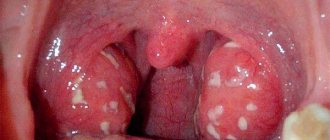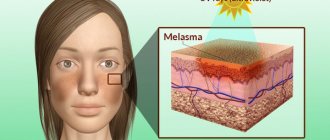A constant companion of colds is a runny nose, or, scientifically speaking, rhinitis. It is also a mandatory manifestation of allergies and the body’s reaction to the presence of harmful and irritating factors in the atmosphere. We are accustomed to not paying much attention to this annoying and not very comfortable symptom, often not treating it and letting the process take its course. But in vain! An untreated runny nose can eventually develop into a chronic form and “delight” the patient throughout the rest of his life. Moreover, it can lead to serious complications. One of the extremely unpleasant forms of such advanced rhinitis will be discussed below.
What is hypertrophic rhinitis
Hypertrophic rhinitis is a form of chronic runny nose, characterized by pathological proliferation of tissues of the nasal cavity. Basically, we are talking about the mucous and submucous membranes, but sometimes the periosteum, as well as bone structures, can be involved in the process. Due to excessive development of the insides of the nose, severe difficulty breathing occurs, up to complete blockage of the nasal passages. The sense of smell suffers, and overall health also becomes far from ideal.
This pathology requires increased attention and urgent treatment. Its distinctive feature is the low effectiveness of medications; in most cases, the disease requires surgical intervention of varying degrees of invasiveness.
Phases of development
Hypertrophic rhinitis is characterized by inflammation of the mucous membranes of the nasal cavity, which is accompanied by hyperplasia (proliferation) of these membranes.
The process consists of several phases:
- The first is hypertrophy of soft membranes. Only the mucous membranes become inflamed, the ciliary epithelium is practically not affected, and other structures are not involved in the process.
- The second is accompanied by damage to glandular tissues and ciliated epithelium. Also, the inflammatory process can affect muscle fibers and vessel walls. The result is compression of the blood and lymphatic vessels.
- The third is the edematous stage. Glandular tissues, blood vessels, mucous membranes, and ciliated epithelium are affected. The symptoms are clearly expressed. The degree of damage may vary, as well as the structure and nature of the surface of the nasal turbinates. Changes may affect bone structures (surgery required).
Classification
According to the mechanism of occurrence and extent of the disease, rhinitis is classified as follows:
| Rhinitis | ||||||||
| Infectious | Non-infectious (vasomotor) | |||||||
| Spicy | Chronic | neurovegetative | allergic | |||||
| catarrhal (uncomplicated) | hypertrophic | atrophic | seasonal | year-round | ||||
| local | diffuse | simple | fetid (ozena) | |||||
Acute rhinitis, as a rule, occurs as one of the symptoms of damage to the body by a viral or bacterial infection (cold, flu, etc.).
Symptoms of catarrhal rhinitis are characterized by a long course with periodic exacerbations, while there are no pathological changes in the structure of the nasal cavity.
Hypertrophic rhinitis is characterized, as mentioned above, by abnormal proliferation of tissues lining the nasal cavity, with possible involvement of bone elements. May affect specific areas (usually the inferior turbinates) in a localized form, or may involve all nasal structures.
This article contains folk remedies for nasal congestion without a runny nose.
What to do when a child has a severe runny nose and nasal congestion is indicated here.
What is the best remedy for the treatment of runny nose in children is most often taken, indicated here: https://lechim-gorlo.ru/n/detskoe-zdorove/effektivnoe-sredstvo-ot-nasmorka-2.html
With atrophic rhinitis, the mucous membrane dies. In the case of the fetid form, crusts form in the nose with a characteristic unpleasant odor.
Vasomotor rhinitis is a consequence of a violation of the reflex mechanisms of reaction to certain irritants (low air temperature, pungent odor in the neurovegetative form) or exposure to various allergens.
Diagnostic methods and symptoms of the disease
The hypertrophic form of rhinitis has similar symptoms to vasomotor and catarrhal rhinitis. Therefore, only a qualified ENT doctor can make a correct diagnosis through rhinomanometric and endoscopic examinations of the nasal cavity.
Using these diagnostic methods, the specialist determines the course of the disease, the nature of changes in the mucous membranes, the exact location of the pathological focus, and examines the condition of nearby tissues. Often, specialists resort to rhinopneumometry, which can be used to assess the condition of the patient’s nasal cavity and determine the volume of air that passes through the nasal passages.
The main symptoms that characterize hypertrophic rhinitis include:
- Long-term nasal congestion.
- Difficulty in nasal breathing.
- Frequent headaches.
- Decreased hearing and sense of smell.
- Nasality.
Patients also complain of nasal congestion, which is also characteristic of vasomotor rhinitis.
The patient’s breathing directly depends on in which part of the nasal passages the pathological process is localized:
- If tissue growth of the nasal mucosa occurs in the area of the anterior ends of the inferior turbinates, the patient experiences severe difficulty in bilateral nasal breathing.
- If hyperplasia occurs in the area of the posterior inferior conchae, the patient complains of difficulty breathing when inhaling and exhaling.
- With hypertrophic rhinopathology, secretory contents are abundantly released from the nasal passages, and the timbre of the voice changes.
In addition to collecting complaints and studying anamnesis, a specialist for diagnosing hypertrophic rhinitis can refer the patient to:
- endoscopy - examination of the internal walls of the nasal cavity in order to determine the degree of turbinate hypertrophy, the nature of changes in the mucous membrane, and identify pathological discharge and crusts;
- test with anemization - an adrenaline solution is used, which causes spasm of the vessels of the mucous membrane; in the case of a hypertrophic form of rhinitis, the test will be negative (there is no thickening of the nasal mucosa);
- radiography of the paranasal sinuses or computed tomography of the anatomical area to exclude sinusitis.
Important. To exclude an allergic or infectious process, a blood test is prescribed. If necessary, the patient is referred for consultation to an allergist, neurologist, or pulmonologist.
Differential diagnostics must be carried out with other forms of rhinitis, sinusitis, specific infections with similar symptoms (tuberculosis, syphilis), Wegener's granulomatosis.
Causes and predisposing factors
There are quite a lot of them. Here are the main ones:
- multiple untreated episodes of acute rhinitis;
- advanced chronic catarrhal rhinitis, as well as vasomotor rhinitis in the absence of proper treatment;
- prolonged exposure to polluting factors (dust, soot, various gases, unsuitable climate, etc.);
- uncontrolled and unjustified use of vasoconstrictor drugs;
- diseases of the cardiovascular system (arterial hypertension, vascular atherosclerosis), affecting microcirculation in the area of the nasal mucosa;
- endocrine system disorders;
- severe curvature of the nasal septum;
- adenoids not removed in time;
- reduced immunity.
It is obvious that the development of hypertrophic rhinitis is greatly facilitated by an inattentive or frankly disregardful attitude towards one’s own health, reluctance to be treated in the hope that “it will go away on its own,” and an unreasonable passion for various vasoconstrictors that only temporarily eliminate the discomfort of a runny nose.
Etiology of the disease
Given the chronic course of the disease, the trigger for development is chronic rhinitis of various natures. Clinicians consider hypertrophy of the nasal membranes as a secondary pathology against the background of the following conditions:
- anatomical defects of the nose (deviated septum, cartilage fusion after injury);
- prolonged exposure to irritants (industrial dust, chemicals, allergens);
- dry or frosty air (accompanied by the formation of crusts in the nose);
- persistent circulatory disorders due to autoimmune pathologies;
- long-term use of vasoconstrictor drugs.
Frosty air is a possible cause of hypertrophic rhinitis.
The main factor is still considered to be decreased immunity, chronic rhinorrhea, and allergic rhinitis. The transition from acute rhinitis to chronic hypertrophic rhinitis takes a long time, from six months to several years.
Symptoms and signs
The symptoms of the disease are very similar to those of other forms of the common cold. Among them:
- constant nasal congestion, difficulty breathing;
- opaque nasal discharge, possible clots of pus;
- headache;
- hyposmia or anosmia (decreased or disappeared sense of smell);
- hearing loss;
- change in voice timbre, nasality.
If this set of symptoms appears, you should immediately consult a doctor. They do not always indicate hypertrophic rhinitis; sinusitis with sinusitis may well give a similar picture. But any of these diseases requires immediate treatment in order to minimize the risk of severe complications and prevent radical surgery.
Prevention measures
The main goal of prevention is to strengthen the immune system and ensure stable remission in the chronic course of the disease. It is important to promptly treat respiratory diseases and sinusitis. To improve the body's resistance, it is recommended to take immunostimulants, vitamin complexes, regularly ventilate rooms, and humidify the air.
The prognosis for hypertrophic rhinitis depends on the volume and adequacy of medical intervention and the patient’s general clinical history. A positive outcome is possible only if all medical recommendations are followed. For patients with hypertrophic rhinitis that is difficult to treat, resort therapy is indicated.
Diagnostics
Due to the similarity of manifestations with other types of the disease, making an accurate diagnosis requires a detailed examination by an otolaryngologist using a special reflector that allows you to look deep into the nasal cavity. Also, recently, endoscopic examinations are increasingly being carried out, giving a clear and detailed picture of the condition of the nasopharynx. Additionally, the doctor may prescribe a computed tomography and x-ray of the paranasal sinuses, as well as conduct a rhinopneumometric test to assess the passage of air through the nasal canals.
What good remedy for the common cold is used most often is indicated in the article.
How a runny nose is treated in the first trimester of pregnancy is indicated here.
What is the best remedy for a runny nose during pregnancy 2nd trimester is indicated in this article: https://lechim-gorlo.ru/g/lechenie/chem-lechit-nasmork-pri-beremennosti-2-trimestr.html
You should not try to diagnose yourself at home based solely on external symptoms. Only a specialist with the necessary skills and equipment can assess the condition of the nasopharynx and identify the proliferation of its structures.
Treatment methods
Folk remedies
Salt rinsing for sinusitis is one of the popular folk methods of treatment.
In the initial stages, you can try to treat hypertrophic rhinitis with folk recipes for a runny nose. Among them:
- rinsing the nose with a solution of sea salt (possibly with the addition of a small amount of iodine);
- washing with herbal infusions and decoctions (usually based on peppermint, sage, plantain, chamomile, horsetail, St. John's wort, agrimony, etc.);
- inhalation of water vapor with the addition of peppermint leaves and a variety of essential oils (lemon, lavender, orange, tea tree);
- sniffing a dry mixture of crushed rue herb, leaf cap and hoofed grass root;
- inserting cotton honey swabs into the nasal passages (if you are not allergic to honey!).
However, remember that it is quite difficult to quickly cure a runny nose in an adult using folk remedies alone.
Conservative therapeutic methods
Also, with mild symptoms and a low degree of hypertrophy of nasal structures, the following effects may be justified:
- physiotherapy - UHF, etc.;
- irradiation of the nasal concha with ultraviolet light;
- light massage of the mucous membranes;
- instillation of hydrocortisone suspension.
However, given the nature of the disease (proliferation of the nasal membranes), the use of any medications or folk remedies, as well as conservative procedures, usually does not give any significant effect.
Surgical treatment
The degree of intervention directly depends on the patient’s condition. In the early stages of the disease, the following minimally invasive surgical procedures are usually used:
- chemical or electrical cauterization of overgrown structures (now almost never done);
- ultrasound resection;
- laser destruction;
- excision of pathologically overgrown vessels.
In case of significant hypertrophic changes in the nasal structures, a more radical intervention is resorted to:
- conchotomy (removal of mucous membranes);
- osteoconchotomy (the bony tip of the inferior turbinate is additionally removed).
It should be noted that with the introduction of modern endoscopic technologies, the traumatic impact of such operations has significantly decreased, and the recovery period has been reduced to several days. The procedures themselves are performed under general or local anesthesia, do not cause severe discomfort and take no more than 20 minutes.
Treatment of the disease
Such a disease is practically not amenable to drug therapy, especially for the chronic form of the disease. At an early stage, treatment of hypertrophic rhinitis is carried out using:
- irradiation of the nasal cavity with ultraviolet radiation;
- exposure to high frequency radiation;
- administration of medicinal suspensions;
- the use of decongestants, which are aimed at reducing swelling.
Such procedures are effective only for mild cases of the disease and are due to the fact that they eliminate only minor clinical manifestations of the disease and prevent further development of the disease process.
In cases where the tissues of the mucous layer have grown significantly, the only method of therapy is surgery. Treatment of chronic hypertrophic rhinitis involves one of the following operations:
- conchotomy – involves excision of the mucous membrane in the area of the lower and middle nasal concha;
- laser submucosal vasotomy – involves removal of vessels under the membrane;
- galvanocautics or electrocoagulation. This method of surgery for hypertrophic rhinitis is based on cauterization of mucous tissues with electric current;
- cryodestruction - using the influence of a cryoapplicator cooled with liquid nitrogen on hypertrophied areas;
- ultrasonic disintegration of nasal turbinates;
- osteoconchotomy – involves removing the bone edge.
Treatment of hypertrophic rhinitis
Surgeries are also advisable if conservative therapy is ineffective.
Another part of complex therapy is alternative medicine, which involves the use of the following components for rinsing the nasal cavity:
- mint and chamomile;
- St. John's wort and sage;
- plantain and honey;
- table or sea salt.
Before using such therapy methods, you should consult your doctor. When trying to treat the disease on your own with alternative medicine recipes, there is a risk of aggravating the inflammatory process and its spread.
Consequences and complications
In advanced cases of hypertrophic rhinitis, the patient completely loses the ability to distinguish odors
It is not difficult to guess what an advanced disease leads to in the absence of proper treatment. The inability to breathe normally through the nose results in lack of sleep, chronic fatigue and oxygen deficiency in the tissues. Overgrown nasal structures interfere with normal lymphatic drainage from the cranial cavity, resulting in permanent headaches and disability.
If in the early stages of the disease the disturbance of smell is reversible, then in advanced cases the patient completely loses the ability to distinguish odors. Due to the constant presence of a purulent focus in the nose, the ears also suffer: hearing deteriorates, otitis develops. Severe hypertrophy of the anterior parts of the inferior turbinates can cause blockage of the nasolacrimal ducts. As a result - impaired tear drainage, conjunctivitis.
The voice becomes unpleasant and nasal. The mouth is open almost all the time, as with adenoids. Irritability inevitably increases. In general, the standard of living suffers significantly.
Classification of types and forms of pathology
The classification of hypertrophic rhinitis allows you to quickly begin timely therapy and assess the likelihood of complications. The classification considers the criteria for the form, course and stage of development of the pathological process.
According to the form of the disease
Clinicians distinguish the following forms of hypertrophic rhinitis:
- cavernous - false hypertrophy, when the growth is not of an organic, but of a functional nature (due to an anomaly in the structure of the nasal passages);
- fibrous – characterized by a morphological change in the structure of the epithelial membranes;
- edematous – growth is caused by chronic swelling of the mucous nasal passages (more often occurs as a consequence of allergic rhinitis);
- mixed or combined - the symptom complex resembles the course of several forms of hypertrophic changes.
According to the clinical course, acute and chronic hypertrophic rhinitis are distinguished. The acute phase is characterized by exacerbation, expressed by vivid symptoms and an aggressive course.
According to the nature of the flow
There are several other forms that characterize the characteristics and course of the disease:
- vasomotor – sudden onset and disappearance of symptoms, rarely contributes to disruption of the morphostructure of the membranes of the nasal passages;
- limited - hypertrophy is observed in one localized area of the nasal passages;
- diffuse – a consequence of a chronic total hyperplastic process.
Diffuse hypertrophic rhinitis
Total hypertrophic rhinitis is the most difficult to treat; the symptoms are constant, worsen the quality of life, and are difficult to treat with medications.
By stage of development
The following stages are distinguished:
- Stage I – mild hypertrophy with moderate swelling and redness of the membranes, with minor damage to the ciliated epithelium;
- Stage II – gland hypertrophy, metaplasia of the ciliated epithelium, destruction of the structure of submucosal muscle fibers;
- Stage III - edematous, myxomatous or polypoid, characterized by infiltration of all membranes of the nasal passages, disruption of the structure of lymphatic and blood vessels, glands.
ICD-10 code – J31.0 – hypertrophic and chronic rhinitis. The danger of persistent rhinorrhea cannot be underestimated, since in the absence of adequate treatment of the acute form it contributes to its rapid chronicity.
Video
This video will tell you what types of rhinitis exist.
As trivial as it may sound, the best method of combating hypertrophic rhinitis is prevention. By following a number of not very complicated rules, you can reliably protect yourself from such an unpleasant illness.
- It is always necessary to fully treat any runny nose. Do not abuse vasoconstrictor drugs, strictly follow the doctor’s recommendations.
- When working in conditions of air pollution, use protective equipment (masks, respirators, etc.).
- If you have an allergy, try to minimize exposure to the allergen, avoid being in places where there is a high concentration of it, or take appropriate antihistamines.
- Temper the body within reasonable limits.
If desired, this list can be continued, but the general principle is clear: you need to at least a little monitor your own health and not let pathological processes take their course. Then you won’t have to worry about a simple runny nose, which tends to turn into a dangerous chronic rhinitis.
Clinical picture
Treatment of chronic hypertrophic rhinitis depends on the symptoms. This pathology is manifested by subjective and objective symptoms. Subjective symptoms include difficulty in nasal breathing. In severe forms of chronic catarrhal rhinitis, nasal breathing is absent. Vasomotor rhinitis is a chronic pathology in which vascular tone is disrupted. If a person has hypertrophic rhinitis, there is copious discharge from the nose. As this pathology progresses, sleep deteriorates, fatigue increases, and the sense of smell noticeably deteriorates. The patient may complain that there is a foreign body in the nasopharynx.
As a result of this problem, blood circulation is impaired and headaches occur. A progressive disease affects thinking abilities: a person’s memory deteriorates. Symptoms and treatment in adults may differ: when choosing treatment tactics, the doctor takes into account the degree of inflammation. If we talk about objective symptoms, it is worth noting that the patient’s mouth is constantly open. A person closes it only when he pays attention to it. If the patient begins physical labor, he breathes only through his mouth.
With chronic hypertrophic rhinitis, a nasal voice appears: this phenomenon is associated with damage to the palate. Curing rhinitis is not easy, but you need to make every effort to do so. Hypertrophic diffuse and vasomotor rhinitis occur slowly. If not treated with medication, the disease will progress and lead to complications.












